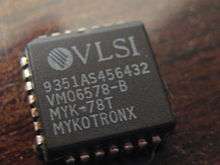Clipper chip

The Clipper chip was a chipset that was developed and promoted by the United States National Security Agency[1] (NSA) as an encryption device, with a built-in backdoor, intended to be adopted by telecommunications companies for voice transmission. It was announced in 1993 and by 1996 was entirely defunct.
Key escrow
The Clipper chip used a data encryption algorithm called Skipjack[1] to transmit information and the Diffie-Hellman key exchange-algorithm to distribute the cryptokeys between the peers. Skipjack was invented by the National Security Agency of the U.S. Government; this algorithm was initially classified SECRET, which prevented it from being subjected to peer review from the encryption research community. The government did state that it used an 80-bit key, that the algorithm was symmetric, and that it was similar to the DES algorithm. The Skipjack algorithm was declassified and published by the NSA on June 24, 1998. The initial cost of the chips was said to be $16 (unprogrammed) or $26 (programmed), with its logic designed by Mykotronx, and fabricated by VLSI Technology, Inc (see the VLSI logo on the image on this page).
At the heart of the concept was key escrow. In the factory, any new telephone or other device with a Clipper chip would be given a cryptographic key, that would then be provided to the government in escrow. If government agencies "established their authority" to listen to a communication, then the key would be given to those government agencies, who could then decrypt all data transmitted by that particular telephone. The newly formed Electronic Frontier Foundation preferred the term "key surrender" to emphasize what they alleged was really occurring.[2]
Backlash


Organizations such as the Electronic Privacy Information Center and the Electronic Frontier Foundation challenged the Clipper chip proposal, saying that it would have the effect not only of subjecting citizens to increased and possibly illegal government surveillance, but that the strength of the Clipper chip's encryption could not be evaluated by the public as its design was classified secret, and that therefore individuals and businesses might be hobbled with an insecure communications system. Further, it was pointed out that while American companies could be forced to use the Clipper chip in their encryption products, foreign companies could not, and presumably phones with strong data encryption would be manufactured abroad and spread throughout the world and into the United States, negating the point of the whole exercise, and, of course, materially damaging U.S. manufacturers en route. Then-Senators John Ashcroft and John Kerry were opponents of the Clipper chip proposal, arguing in favor of the individual's right to encrypt messages and export encryption software.[3]
The release and development of several strong cryptographic software packages such as Nautilus, PGP[4] and PGPfone was in response to the government push for the Clipper chip. The thinking was that if strong cryptography was freely available on the internet as an alternative, the government would be unable to stop its use.
Technical vulnerabilities

In 1994, Matt Blaze published the paper Protocol Failure in the Escrowed Encryption Standard.[5] It pointed out that the Clipper's escrow system has a serious vulnerability: the chip transmitted a 128-bit "Law Enforcement Access Field" (LEAF) that contained the information necessary to recover the encryption key. To prevent the software that transmitted the message from tampering with the LEAF, a 16-bit hash was included. The Clipper chip would not decode messages with an invalid hash; however, the 16-bit hash was too short to provide meaningful security. A brute-force attack would quickly produce another LEAF value that would give the same hash but not yield the correct keys after the escrow attempt. This would allow the Clipper chip to be used as an encryption device, while disabling the key escrow capability.[5]:63 In 1995 Yair Frankel and Moti Yung published another attack which shows that the key escrow device tracking and authenticating capability (namely, the LEAF) of one device, can be attached to messages coming from another device and will nevertheless be received, thus bypassing the escrow in real time. [6] In 1997, a group of leading cryptographers published a paper, "The Risks of Key Recovery, Key Escrow, and Trusted Third-Party Encryption", analyzing the architectural vulnerabilities of implementing key escrow systems in general, including but not limited to the Clipper Chip Skipjack protocol.[7] The technical flaws described in this paper were instrumental in the demise of the Clipper chip as a public policy option. While many leading voices in the computer science community expressed opposition to the Clipper Chip in general and key recovery in general, some supported the concept, including Dorothy E. Denning.[8]
Lack of adoption
The Clipper chip was not embraced by consumers or manufacturers and the chip itself was no longer relevant by 1996. The U.S. government continued to press for key escrow by offering incentives to manufacturers, allowing more relaxed export controls if key escrow were part of cryptographic software that was exported. These attempts were largely made moot by the widespread use of strong cryptographic technologies, such as PGP, which were not under the control of the U.S. government.
However, strongly encrypted voice channels are still not the predominant mode for current cell phone communications.[9] Secure cell phone devices and smartphone apps exist, but may require specialized hardware, and typically require that both ends of the connection employ the same encryption mechanism. Such apps usually communicate over secure Internet pathways (e.g. ZRTP) instead of through phone voice data networks.
Later related debates
Following the Snowden disclosures from 2013, Apple and Google announced that they would lock down data stored on their smartphones with encryption, in a way so that Apple and Google could not break the encryption even if ordered to do so with a warrant.[10] This prompted a strong reaction from the authorities, with one of the more iconic responses being the chief of detectives for Chicago’s police department stating that "Apple will become the phone of choice for the pedophile".[11] Washington Post posted an editorial insisting that "smartphone users must accept that they cannot be above the law if there is a valid search warrant", and after agreeing that backdoors would be undesirable, suggested implementing a "golden key" backdoor which would unlock the data with a warrant.[12][13] The members of the "The Risks of Key Recovery, Key Escrow, and Trusted Third-Party Encryption" 1997 paper, as well as other researchers at MIT, wrote a follow-up article in response to the revival of this debate, arguing that mandated government access to private conversations would be an even worse problem now than twenty years ago.[14]
See also
- Bullrun (decryption program)
- Cryptoprocessor
- Crypto: How the Code Rebels Beat the Government—Saving Privacy in the Digital Age by Steven Levy
- Trusted Platform Module
References
- 1 2 "Clipper Chip - Definition of Clipper Chip". computer.yourdictionary.com. Retrieved 2014-01-11.
- ↑ "Clipper Chip". cryptomuseum.com. Retrieved 2014-01-11.
- ↑ Summary of Encryption Bills in the 106th Congress
- ↑ Philip Zimmermann - Why I Wrote PGP (Part of the Original 1991 PGP User's Guide (updated in 1999))
- 1 2 Blaze, Matt (August 20, 1994). "Protocol Failure in the Escrowed Encryption Standard" (PDF). Proceedings of the 2nd ACM Conference on Computer and Communications Security: 59–67.
- ↑ Y. Frankel and M. Yung. Escrow Encryption Systems Visited: Attacks, Analysis and Designs. Crypto 95 Proceedings, August 1995
- ↑ The Risks of Key Recovery, Key Escrow, and Trusted Third-Party Encryption
- ↑ Denning, Dorothy E. (July 1995). "The Case for Clipper (Clipper Chip offers escrowed encryption)". MIT Technology Review.
- ↑ Timberg, Craig; Soltani, Ashkan (December 13, 2013), "By cracking cellphone code, NSA has ability to decode private conversations", The Washington Post, retrieved August 18, 2015,
More than 80 percent of cellphones worldwide use weak or no encryption for at least some of their calls.
- ↑ http://blog.cryptographyengineering.com/2014/10/why-cant-apple-decrypt-your-iphone.html
- ↑ Craig Timberg and Greg Miller (25 Sep 2014). "FBI blasts Apple, Google for locking police out of phones". The Washington Post. Retrieved 1 Apr 2016.
- ↑ Editorial Board (3 Oct 2014). "Compromise needed on smartphone encryption". The Washington Post. Retrieved 1 Apr 2016.
- ↑ Mike Masnick (6 Oct 2014). "Washington Post's Clueless Editorial On Phone Encryption: No Backdoors, But How About A Magical 'Golden Key'?". Tech Dirt. Retrieved 1 Apr 2016.
- ↑ Abelson, Harold; et al. (July 6, 2015). "Keys Under Doormats: Mandating insecurity by requiring government access to all data and communications". MIT Computer Science and Artificial Intelligence Laboratory.
External links
- Clipper Chip Q&A
- Clipper Chip White House Statement
- The Evolution of US Government Restrictions on Using and Exporting Encryption Technologies (U), Micheal Schwartzbeck, Encryption Technologies, circa 1997, formerly Top Secret, approved for release by NSA with redactions September 10, 2014, C06122418
- Oral history interview with Martin Hellman Oral history interview 2004, Palo Alto, California. Charles Babbage Institute, University of Minnesota, Minneapolis. Hellman describes his invention of public key cryptography with collaborators Whitfield Diffie and Ralph Merkle at Stanford University in the mid-1970s. He also relates his subsequent work in cryptography with Steve Pohlig (the Pohlig-Hellman system) and others. Hellman addresses key escrow (the so-called Clipper chip). He also touches on the commercialization of cryptography with RSA Data Security and VeriSign.